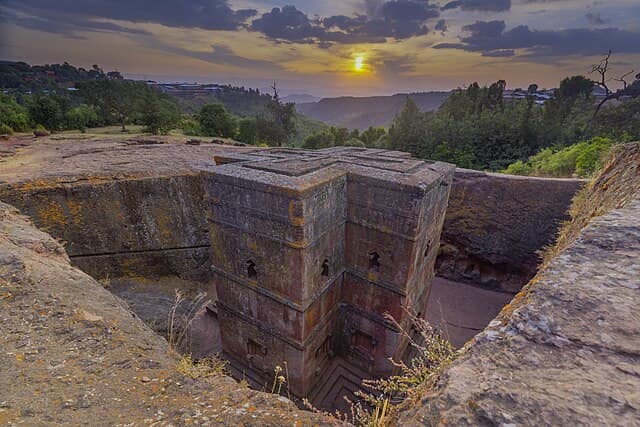The Lalibela church in Ethiopia is a site to behold. Situated in the North of Addis Ababa, Amhara region, it’s a symbol of great architectural design and religious devotion. The Rock-Hewn Church, built out of solid rock, has been a UNESCO World Heritage Site since 1978.
Sitting at an altitude of 8,200 feet, the origins of this monument are a marvel to many. In this article, we share things you should know about this majestic site.
Become an insider. Subscribe to our newsletter for more top trending stories like this!
People Also Read: Least Known Facts About Mansa Abubakari II Exploration
Get traveling items on Amazon.
Has 11 Churches
The Lalibela Church in Ethiopia consists of 11 monolithic cave churches. Every church has distinct religious practices and designs. They also exist in different groups and one of which is separated by the River Jordan:
- Northern Group
- Western Group
- Eastern Group
The Northern group has five churches:
- Biete Golgotha Mikael
- Biete Mariam
- Biete Denagel
- Biete Maskal
- Biete Medhani Alem
The Southern
- Biete Lehem
- Biete Gabriel Rafael
- Biete Abba Libanos
- Biete Amanuel
- Biete Qeddus Mercoreus
The Bete Giyorgis, the Church of St George, is the last of these churches to the west of the Southern group. It’s believed to be the most recent and the best preserved.
According to myths, God’s Angels told him to build the church so to bring heaven down to earth. Once completed, the Angels visited it and blessed those in attendance. We can see what is believed to be the footprints of the stallions St. George rode on in the rocks around the church.
People Also Read: Booker T. Washington: 7 Facts You Probably Didn’t Know
Get a traveling backpack on Amazon.
Constructed in the 12th & 13th Century
These amazing rock-hewn churches of Lalibela were built in the late 12th and early 13th centuries under King Lalibela.
The interiors and exterior are made of volcanic rock and carved out by hand using chisels and hammers, connected by underground tunnels and trenches, plus passageways that lead to hermit caves.
It’s a mind-blowing and complex structure, considering the precision and intricate details of the monument.
People Also Read: Boston Massacre Day: Why Was Crispus Attucks Important?
Become an insider. Subscribe to our newsletter for more top trending stories like this!
Get traveling accessories on Amazon.
Named After an Ethiopian King
The history of Lalibela church in Ethiopia wouldn’t be complete without mentioning King Gebre Mesque Lalibela, who ruled approximately between 1181 and 1221. He’s credited with constructing the Lalibela church in Ethiopia. Scholars credit him with constructing 10 of the churches during his tenure. It adopted his name after he died in 1221.
This was his attempt to build the “New Jerusalem” on African soil that Ethiopians could access. Some of the names of its features are from the original Jerusalem. For example:
- The church of Golgotha
- The river Jordan
- Tomb of Adam
Join our Spotcovery Global Black Community Facebook Group for early access to exclusive content and to share in a lively discussion.
Pilgrimage Site
Ethiopian Orthodox Christians go to the site for prayers. It’s also believed to be the home to priests and monks. Crowds of pilgrims swell during major celebrations, like the feast days and Orthodox Christmas of the Gregorian calendar. It’s a sacred place and those who go seek to experience its transformative power.
People Also Read: 9 Important Black Women in History That Deserve the Limelight
UNESCO World Heritage Site
The architectural acumen of the ancient builders is obvious to see. Its historic, cultural and religious significance earned it a place in the UNESCO World Heritage Site in 1978, for its preservation for future generations.
In 2007, temporary shelters were built over four churches to prevent them from rain damage. This comes as structural damage has been noticed on some parts such as the entrance of the Birt Mariam. To prevent this, progressive work continues to make sure this is done across the site.
Pay for a Visit
The Lalibela churches are a tourist destination. You should be ready to part with $50 to see the great artistry of these buildings. It shouldn’t be a surprise to anyone considering its stature as a UNESCO Heritage Site so if you thought you’d just walk in, sorry. Have some cash in hand.
The Lalibela church of Ethiopia will always be a marvel. Its resilience to withstand the test of time, the details of the buildings and their significance – culturally, historically and religious – excite people’s imagination. Have you visited the site? Let us know your experience.
Nearly 80% of consumers visit directories with reviews to find a local business. List your business for free in our exclusive Spotcovery Black-Owned Business Directory.
Spotcovery offers unique and fresh daily content on Black culture, lifestyle, and experiences. We talk about everything black, black people, black-owned and black-owned businesses. We also deliver authentic and relevant content that will inform, inspire, and empower you! The future of black media is critical to today’s black experience! Our primary audience includes African Americans, Africans, Afro-Caribbean, and people of African heritage. Black culture is for the culture!
Become an insider. Subscribe to our newsletter for more top trending stories like this!





